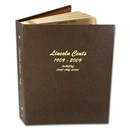Lincoln Wheat Pennies (1909-1958)
Rare Wheat Pennies
A major event in the life of Wheat Pennies is the alteration of its metal content made in 1942 and 1943. While all Americans generally think of Copper pennies and believe that pennies are made of pure Copper, that is not accurate now and has varied many times throughout history. During the conflicts of World War II, facing enemies on both the Eastern and the Western fronts, the government determined that it needed all the copper and tin in the country to put towards munitions for the war effort. In 1942, the United States Mint removed all but a trace of tin from the alloy used for the Wheat Cent, which technically speaking changed the metal from bronze to brass. Further, because the Mint had a supply of existing bronze coining strip already prepared, the Lincoln Cents of 1942 are made from both alloys.
Collect Lincoln Pennies
However, if you find a 1943 penny made out copper, it may be worth quite a bit of money—up to $10,000 or more. This is because any 1943 copper penny is a coin made in error; the Mint accidentally used the wrong planchets when striking the coin. Very, very few of these coins actually made it into circulation. Simply put, some copper planchets left over from previous years were left in the corners of the huge bins that transported the blank planchets around the mint. When they mixed in with the regular zinc plated steel planchets they were processed through the coining presses.
Another indication of a rarer Wheat Penny is a small “S” mintmark under the date of a Lincoln Wheat Penny. This indicates that the penny was minted at the San Francisco mint facility. Collectors fervently seek these particular pennies, and they may trade for higher premiums than common wheat cents. A “D” under the date indicates that the penny was minted in Denver, while lack of a mintmark indicates that the penny was minted in Philadelphia. Further, mint year 1909 also saw some wheat pennies struck with the designer’s initials, “VDB” for Victor D. Brenner, along the bottom rim of the coin just below the wheat stalks. Because fewer pennies were minted with the engraved initials, check your 1909 Lincoln Wheat Penny to see if it has the VDB engraving. This could enhance its value.
Over the years, the Lincoln Wheat Cent underwent various changes. In 1918, the original design featuring the wheat stalks was modified to display a smaller and less prominent rendering due to concerns that the wheat ears resembled German symbols during World War I. This modified version, known as the "Matte Wheat Cent," is particularly sought after by collectors for its historical significance.
Whether your focus is on the elusive copper 1943 copper Cent or other Wheat pennies, explore the value of historic U.S. Mint coins in your collection.
History of the Wheat Penny
The Lincoln Cent might never have existed but for the persistence of U.S. President Theodore Roosevelt. The President had an eye for beauty and believed that America's coins were uninspiring compared to those of European countries. His personal and professional acquaintance with renowned sculptor Augustus Saint-Gaudens added to this conviction, and Roosevelt eventually commissioned Saint-Gaudens to begin redesigning all of the U.S. coinage. Sadly, Saint-Gaudens passed away before he fished the U.S. coins, or we would likely have had a Saint-Gaudens penny, showcasing his signature artistic flair. Instead, we have the familiar profile of President Abraham Lincoln designed by Victor Brenner. Before the Lincoln Wheat Cent, the United States mint refrained from placing the image of a real person, either living or dead, on circulating coins. It was considered undignified. However, slain President Abraham Lincoln was already thought of as an heroic American icon by the turn of the twentieth century, and Roosevelt conceived the idea of featuring Lincoln on an American coin as soon as he viewed sculptor Victor David Brenner's bronze plaque of Lincoln.
Our Selection
APMEX offers Wheat Pennies spanning different years, mintmarks, and conditions, catering to collectors with diverse preferences and budgets. Whether you're seeking a specific date or mintmark to complete a collection or simply looking to acquire a variety of Wheat Pennies for their historical significance, APMEX's inventory provides a wealth of options.
Collectors can explore the selection of individual Lincoln Wheat Cents, allowing them to browse through different years and mintmarks to find the perfect addition to their collection. APMEX also offers rolls and bags of Wheat Pennies, which provide an exciting opportunity to uncover a hidden gem or discover the joy of coin roll hunting.
For those who prefer curated sets, APMEX offers carefully selected assortments of Wheat Pennies, bringing together coins from different years or including significant variations such as the Matte Wheat Cent. These sets offer convenience and a well-rounded collection, allowing collectors to appreciate the evolution of the coin and delve deeper into the history of the Lincoln Wheat Cent.
With APMEX's user-friendly website and reliable service, collectors can confidently explore their selection of Wheat Pennies, knowing they are dealing with a reputable and trusted source. The convenience of online shopping, combined with APMEX's commitment to quality and customer satisfaction, makes it an excellent platform for both seasoned collectors and newcomers to the world of Wheat Pennies.





